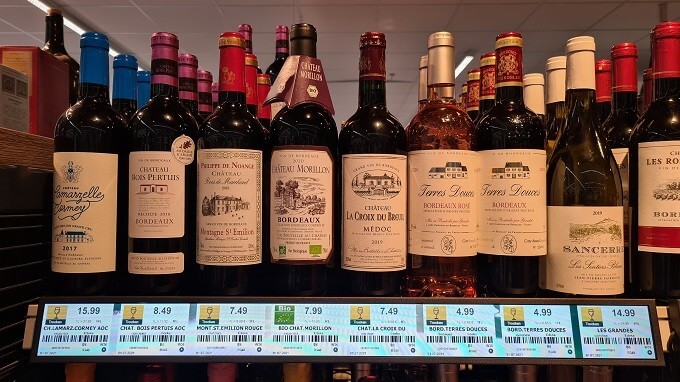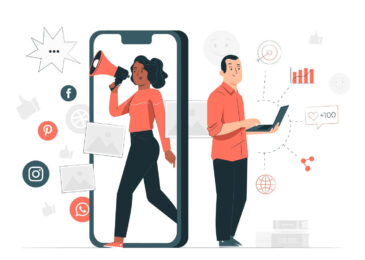How to Use Digital Signage for Marketing: The Essential Guide
How to Use Digital Signage for Marketing: The Essential Guide –
Take a walk down any shopping street: how many shops have put up signs, clamoring for you to look at them?
Probably a lot.
And because businesses know that customers are constantly being bombarded with information, they try even harder to have their signs catch attention. This often means making the signs:
- BIGGER!
- Flashier!
- More colorful!
But if there is one signage strategy that businesses often overlook, it’s going digital.
Also Read – The Future of Digital Marketing Could Be Different Than What You Expect
Digital signage refers to displaying multimedia content on screens, with various content pieces put together into a playlist. Such content can be static images with animated visuals, videos, or even a combination of these. They can even be accompanied by music!
Compared to physical signage, digital signage wins hands down. Because even the most colorful static sign will be less interesting to look at than a digital sign with moving elements. So how can you start using digital signage for your marketing efforts? Read on as we cover:
- 3 reasons to use digital signage
- Where to install digital signage
- How to get started with digital signage
Check out Top 3 reasons to use digital signage for marketing –
1. Pack in more information in an eye-catching manner –
With digital signage, you have much more space for communicating more information.
That’s because you can set up your digital signage to display certain information for a preset period, before transitioning to another piece of content. As a result, a single display signage screen can replace two or more physical signs, saving you a ton of shop space that you can use for other purposes.
Not only that: the digital nature of digital signage means that you aren’t limited to using static content for your signs.
Instead, you can embed videos, text and image animations, and even Hollywood-worthy visual effects—which are bound to help your signs stand out more than just an unmoving image or design.
However, keep in mind that people will need time to read what’s on your digital signage. This means that for a good user experience, each piece of content should stay on the screen for a sufficient duration before it’s replaced with something else. To nail the perfect play period, test your digital signage on yourself and your employees beforehand.
2. Update your (de)signs instantly –
Every now and then, you’ll want to update your signs to showcase your business’ latest products, promotions, prices, and more. If you were using physical signage, this would involve:
- Throwing away all your existing signs,
- Reprinting them to share the new information, and then
- Distributing and putting up your new signs on your business premises.
This is a lot of work, especially if you have multiple branches and need to update your signs for all of them. Accordingly, your new campaign or promotion might take longer to roll out.
And if you discover a typo or mistake in your physical signage, you’d need to repeat the above process to fix the issue.
With digital signage, however, such hassle and delays will be a thing of the past.
Using your digital signage platform, you can effortlessly update your sign content. After that, it’ll take only a few clicks for you to push out your new digital signage to all your screens instantly. Talk about speed and convenience!
3. Elevate your in-store experience –
Despite the growth of e-commerce over the years, businesses can’t afford to overlook the demand for in-person shopping.
In a 2021 survey of 1,000 American consumers conducted by digital signage experience platform Raydiant, for instance, nearly half (or 48%) of them shared that if given a choice, they would prefer to shop at a physical store instead of online.
However, don’t expect customers to come flooding into your physical store just because you have one. You’d still need to put in the effort to cultivate a superior customer experience that gets customers in the mood to visit— and then spend with you.
For example, you could:
- Generate interest in your offerings using attractive animated banners
- Run limited-time discounts that change every hour
- Display ambiance videos to create an immersive in-store shopping experience
And the versatility of digital signage, which can dynamically display any marketing content you can think of, makes doing all of the above possible.
Where to install your digital signage: 3 ideas –
1. Restaurant menu boards –
Depending on your restaurant setup, you may be displaying your menus on physical menu boards instead of handing out paper menus. But what if you had a special promotion?
In this case, you might need to print new menu boards or brochures to advertise it. Either way, you’d be throwing away all these marketing collaterals at the end of the promotion. Not exactly the most environmentally friendly approach.
So why not display your menus using digital signage instead? You’ll be able to update your menus on the fly to reflect your limited-time promotions, then revert to your usual menu once the promotion has ended, with zero physical waste.
For example, Canadian pizza joint Freshslice Pizza uses digital signage to display its menu in its pizza outlets:
2. Shelf labels –
If you run a retail store, you’d know how much of a hassle it is to print and paste all those tiny pricing labels for your products. Especially if you stock hundreds or even thousands of products, and regularly change your prices.
The better solution is to use digital signage to display your prices electronically. While installing digital signage screens for each product you sell will take some initial outlay, you stand to reap significant cost savings afterward.
That’s because you save on the:
- Financial costs of reprinting your pricing labels, whether due to price changes or wear and tear of existing labels
- Manpower costs of replacing your pricing labels, because your staff will no longer have to swap out the labels one by one
Just take a look at these sweet digital signage shelf labels that German supermarket chain Edeka is using:
3. Lobby screens –
Whether you run a hotel, clinic, or some other business that has a lobby on your premises, digital signage is practically a must-have in your lobby.
Customers will gather in your lobby before going about their activities, so it’s a prime place for sharing vital customer information. Using digital signage can help you communicate such information without plastering your lobby walls with countless physical signs.
For inspiration, check out the digital signage that Heart Mountain Hearing Center has installed in its lobbies.
The clinic uses its lobby screens to display information such as:
- Healthcare tips
- Hearing loss-related trivia
- Live weather feeds
- Public health reminders
Such content keeps the clinic’s patients entertained while waiting for their appointments, and can also help put them at ease if they are feeling anxious.
How to get started with digital signage?
Excited by the prospect of using digital signage? Then let’s take a look at how you can get started. And don’t worry if the process sounds daunting—there are platforms that do most of the heavy lifting for you:
1. Create your digital signage content –
The first step is to design your signs. While you can engage an artist to produce your digital signage content from scratch, a graphic design platform offers an especially affordable alternative.
For example, PosterMyWall sports over 1,300 beautiful digital signage templates that you can modify using a drag-and-drop editor. Pick your favorite template, then customize it to fit your signage needs.
You can change the template’s text, colors, or even add videos to animate your digital signage. The possibilities are endless.
Repeat this process to create as many digital content pieces as you need, and put together your digital signage playlist.
2. Install your digital signage content –
Once you’re happy with your digital signage playlist, it’s time to put them up.
Start shopping around for digital signage providers that will supply you with the screens, and install them on your behalf. All you’ll have to do is to feed the screens your digital signage playlist, and watch as your screens come to life with your stunning content.
If you’re using PosterMyWall to design your digital signage, you’ll be glad to know that it has direct integrations with digital signage providers such as Raydiant and NoviSign. This means that you can seamlessly transfer your digital signage content from PosterMyWall to your account with these digital signage providers—no manual exporting or re-importing needed.
After that, add your digital signage content to your playlist, set the duration for each content piece, and then hit play to show off your digital signage to the world.
How will you use digital signage to maximize your marketing efforts?
The signs—pun not intended—are unmistakable: if you want to jazz up your marketing and communication campaigns, then digital signage is the way to go.
Put up your digital signage practically anywhere you’d typically put a static (read: boring) physical sign, then start curating your digital signage playlist. As mentioned, you can tap on a digital signage template from PosterMyWall to craft your digital content, and get outstanding results as if you had paid a professional graphic designer for the job. Your customers will never know the difference.
Your chosen digital signage provider will also oversee the signage installation process, leaving you free to focus on running your business. And if you need to modify your digital signage, simply make the tweaks in your graphic design platform and sync the changes over. You’ll have your screens updated in a flash.
In a world where most businesses still rely on physical signage, digital signage can help you differentiate yourself and compel customers to visit your store over a competitor’s. Don’t miss out on this opportunity to capture maximum attention, communicate information with impact—and ultimately, boost your sales and revenue.
Author Bio –
Siew Ann Tan is a freelance B2B SaaS content writer for the digital marketing, entrepreneurship, and tech niches. She leverages her 4+ years of practical experience in SEO, email marketing, and Instagram marketing to produce creative, well-researched articles for PosterMyWall, WordPress.com, GoDaddy, Fusebill, and others.
Also Read – 7 Ways To Identify The Right Target Audience For Your Brand










